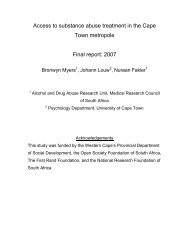Audit of Substance Abuse Treatment Facilities in ... - SA HealthInfo
Audit of Substance Abuse Treatment Facilities in ... - SA HealthInfo
Audit of Substance Abuse Treatment Facilities in ... - SA HealthInfo
- No tags were found...
Create successful ePaper yourself
Turn your PDF publications into a flip-book with our unique Google optimized e-Paper software.
treatment services provided. At present, only limited <strong>in</strong>formation is collected on thefacilities that provide substance abuse treatment services. This <strong>in</strong>formation, typicallyconta<strong>in</strong>ed <strong>in</strong> resource directories, generally consists <strong>of</strong> a brief description <strong>of</strong> the types <strong>of</strong>clients served and services provided.Exceptions to this <strong>in</strong>clude two local-level audits <strong>of</strong> specialist substance abuse treatmentfacilities <strong>in</strong> Cape Town and Gauteng, conducted <strong>in</strong> 2002 and 2004, respectively (Myers &Parry, 2003; Myers, 2004). These audits reported on treatment facility characteristics, thepr<strong>of</strong>ile <strong>of</strong> clients served, the type and range <strong>of</strong> treatment services provided, theaccessibility <strong>of</strong> treatment services to clients from historically underserved groups, andtreatment service monitor<strong>in</strong>g and evaluation processes. In addition, these auditsrecommended that a national audit <strong>of</strong> substance abuse treatment facilities occur on aregular basis to facilitate the collection <strong>of</strong> quality <strong>in</strong>formation on substance abusetreatment services (Myers & Parry, 2003; Myers, 2004). In 2007, an attempt was made toaddress this gap by audit<strong>in</strong>g all known substance abuse treatment facilities <strong>in</strong> Gautengand KwaZulu-Natal prov<strong>in</strong>ces (Myers & Fakier, 2007). This report represents anotherattempt to provide miss<strong>in</strong>g <strong>in</strong>formation on current treatment services <strong>in</strong> the follow<strong>in</strong>gprov<strong>in</strong>ces: Free State, Limpopo, Mpumalanga, North West and the Northern Cape. Assuch, the current project represents a partial response to earlier recommendations andgoes some way towards develop<strong>in</strong>g a national monitor<strong>in</strong>g system <strong>of</strong> substance abusetreatment services.In a context where there is an <strong>in</strong>creas<strong>in</strong>g demand for scarce health and social welfareresources due to the burden caused by poverty, TB, HIV/AIDS and other <strong>in</strong>fectiousdiseases (Freeman, 2000), a study that describes the structure <strong>of</strong> the substance abusetreatment system, describes the extent to which this system adheres to norms andstandards for treatment, and provides evidence as to whether barriers to access<strong>in</strong>gexist<strong>in</strong>g services exist with<strong>in</strong> this system is useful. Through identify<strong>in</strong>g gaps <strong>in</strong> currentservice delivery, this study could help guide the design <strong>of</strong> policies to improve servicedelivery and could also assist plann<strong>in</strong>g and decision-mak<strong>in</strong>g around substance abusetreatment services by suggest<strong>in</strong>g ways <strong>in</strong> which treatment service delivery can beimproved (Th<strong>in</strong>d & Andersen, 2003).17
















